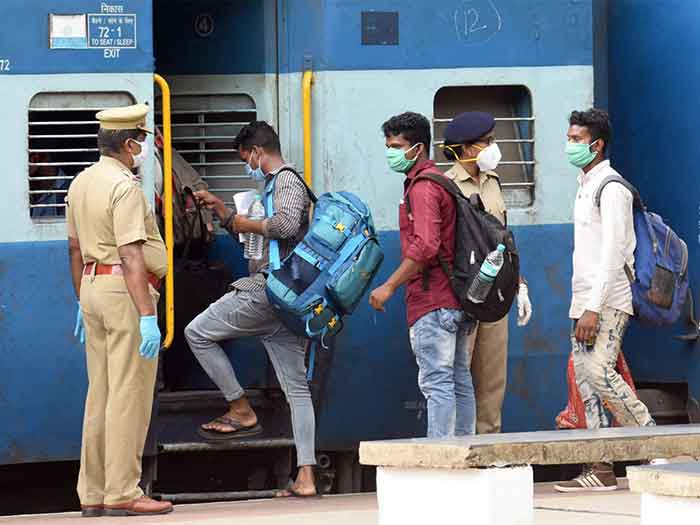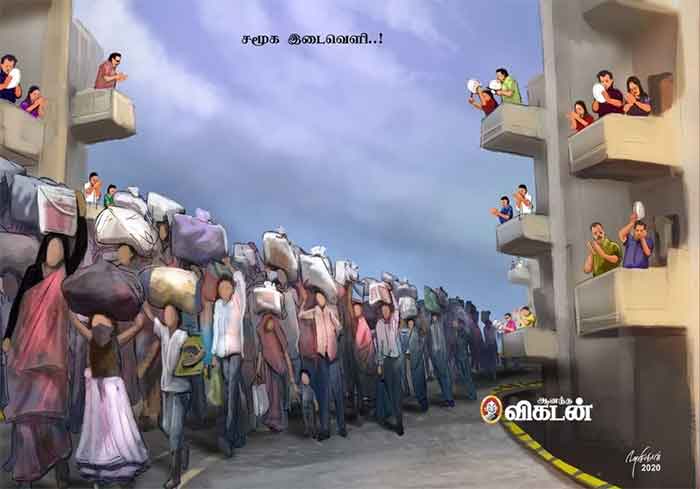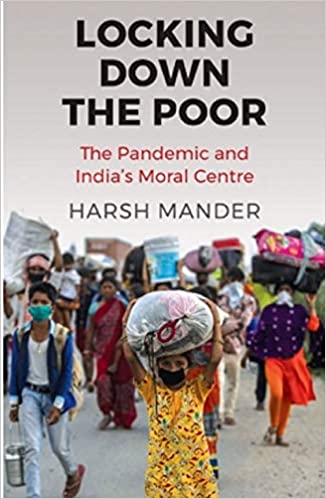Co-Written by Sarbeswar Padhan and Pankaj K. Naik

The ongoing episodic lockdown against the novel coronavirus has unfolded migration crisis in the country. One would hardly disagree with the fact that it is the migrant workers who have suffered the most due to the prevailing economic and political turmoil conditioned by the pandemic. The pandemic has made the invisible visible – the enduring suffering of migrant workers, and not to miss, their will to fight it back. This unprecedented event has also, in many ways, debunked the government’s claims for employment generation through various flagship programmes. Moreover, the painful movement of migrant workers to their native places – mostly to BIMARU states which covertly includes Odisha as well – exposes an extreme regional inequality that has been unabated since the adoption of new economic policy. According to the recent SBI Ecowrap Report 2020, the states like Uttar Pradesh, Bihar, Jharkhand, Odisha and West Bengal has accounted for 90 per cent of total migrants; and it is estimated that around 58 lakhs migrants have gone back to their home states.
Like any other underdeveloped states, Odisha also sends millions of distress migrant workers every year to affluent pockets of the country for their survival. The Center for Migration and Labour Solution (2014) reports that on an average 30 per cent of the households has one or more members migrating for the work from the state. Further, it observes that “the average number of migrants from a family for the western region is 1.78 as compared to 1.27 of the coastal regions.” In Odisha, the nature of migration has both spatial and social dimension. For example, the seasonal migration, often referred to ‘dadan’, meaning ‘indebted migrants’, is very pervasive in the western region; whereas the coastal region experiences more of skilled migration.
Following the lockdown, according to the recent Government of Odisha estimates, around six lakh migrant workers, most of them are distressed-driven, have returned to the state. The government has undertaken various measures to deal with the migrant workers: provided cash incentives for voluntary home quarantine, advance ration and social provisioning for all the beneficiaries and cash transfer to migrants on the completion of the quarantine period, among other things. The government has also promised to provide employment opportunities under various schemes, especially under the Mahatma Gandhi National Rural Employment Guarantee Scheme (MGNREGS). These steps are commendable. However, we are of the opinion that these ‘provisioning’ might not be instrumental in discouraging the distress migration from the state. In this article, we try to briefly examine why is it that after decades of sustained growth and a plethora of welfare schemes, Odisha remains one of the hotspots of distress migration? Secondly, will the pandemic bring an end to the vicious cycle of distress migration from the state?
ECONOMIC GROWTH THAT DID NOT TRICKLE DOWN
The state gross domestic product of Odisha has been growing steadily for the last couple of decades. In the previous fiscal year 2019-20, the state has witnessed a growth rate of 6.2 per cent against the national average of 5 per cent. The main driver of the growth, as in the case of other states, remains the service sector. The industrial sector, especially extractive industries, has emerged as one of the main drivers of the growth in the state. However, when it comes to employment generation, it has failed miserably. Despite its shrinking share (19 per cent) in total output, agriculture and allied activities continue to absorb half of its workforce (48.8 per cent). In a developing economy, theoretically, shrinking agricultural output with continuing overdependence on it for employment fuels distress migration to the cities. Odisha shows a classic case of this economic dualism.
A decade of sustained growth has indeed helped the state to reduce its absolute poverty. Odisha witnessed the largest decline in the poverty rate from 57.5 per cent in 2004-05 to 37.3 per cent in 2009-10. However, these poverty figures – derived from monthly per capita consumption expenditure (MPCE), which also factors in food subsidy (PDS) – do not tell us much about the poverty intensity. According to the District Level Household Survey (DLHS-3, 2007-08), the state has nearly half of the households (48.5 per cent) – the highest proportion among all the states – in the lowest wealth quintile. The figure clearly shows that material poverty has not come down proportionately vis-à-vis consumption poverty. This persistence of acute poverty among the masses – which remains one of the main drivers of distress migration – has been caused by lack of employment opportunities in the state. The ruthless promotion of ‘extractive capital’ at the cost of agricultural and forest economy has led to the massive dispossession of Adivasis and Dalits from their immediate economy and thereto distress migration for new livelihood possibilities.
LAND, CREDIT AND THE DISTRESS MIGRATION
In addition to the above-mentioned macroeconomic factors, a shrinking landholding size among the farmers has also abetted the seasonal distress migration from the state, especially from the western region. Farm size distribution in the state indicates that about 75 per cent of farm units is less than one hectare (2.47 acres) of land during 2015-16 (NABARD,2016-17). On the other hand, decrease in the medium and large landholding without much decline in the operational area suggests the growing concentration of capital in fewer hands. In other words, the transfer of land from the marginal farmers to the rural elite is often facilitated by their indebtedness. The lack of accessibility of formal credit at ease often pushes the marginal farmers to have recourse to highly exploitative informal credit network, with an interest rate as high as 50 per cent per month. This process has created a vicious cycle of indebtedness – to pay the debt, the proletariat resorts to migration. According to the NSSO (70th round, 2012-13) estimate, Odisha has 7.8 million households living in rural areas, of which 4.4 million are directly dependent upon agricultural activities. Of these agricultural households, more than half of them (57.5%) is reported to have indebted. The enduring indebtedness, along with shrinking output per household, has abetted the seasonal migration in the state. The proportion of out-migration is high among the small and marginal household (NSSO, 2007-08).
What about those out of land? Their situation is precarious. The lack of non-farm activities in the locality, coupled with the failure of the state in providing a sustained livelihood opportunity, has made this proletariat class vulnerable to systematic exploitation. They turn to sardar – the local labour contractors who recruit labour on behalf of the seth, the brickkiln owner – for advance to meet their contingencies in exchange for their collective labour-power (often referred as patharia) to be invested in some distant exploitative brickkiln industry at a pre-defined piece rate. The plight of migrant workers often gets reported in the news for all wrong reasons: inhuman treatment, captivity and hostages, sexual harassment, deaths at the workplace, to mention a few. It reached its limit when five years back, a few labour contractors (sardar) chopped off the hands of two migrant workers.
WELFARE SCHEMES AND ACCESS TO ENTITLEMENT
It is not that in Odisha, there do not exist welfare programmes to address the issue of poverty and distress migration. Like any other states, the state has a plethora of welfare schemes. The state has also devised both short-term and long-term programmes to safeguard the livelihoods of marginalised social groups. Moreover, with respect to KBK (Kalahandi-Bolangir-Koraput), the hotspots of distress migration, the state has been among a very few states to have centrally funded special programmes for poverty alleviation. In 1975 the state had enacted Dadan Labor (Control and Regulation) Act, an act to protect and safeguard the interests of ‘indebted migrants’, which had inspired the centre to pass the Inter-State Migrant Workmen Act in 1979. Despite all these policies, however, the state continues to send millions of distress migrants. What explains this phenomena?
It suggests that, among other things, such policies remain largely ineffective in addressing its stated objectives. For example, take the case of MGNREGA, which has emerged as the preferred policy choice to combat joblessness among the migrant workers. In Odisha, however, it remains one of the biggest failures and faces a trust deficit from the workers. In 2007, The Centre for Environment and Food Security (CEFS), had investigated “rural job scam” in the state and had observed that “about 75 per cent of the MNREGA funds spent in Orissa has been siphoned and pocketed by the government officials and this loot has been very participatory and organised.” Evidence also shows that the average wage given to labourers are way below the official wage rate. This prompted the Supreme Court to order the CBI to investigate into the matter in December 2010. The fate of most of the welfare schemes in the state faces similar challenges of ‘collective’ corruption. The process has led to the ‘entitlement’ failure in the state.
CONCLUDING OBSERVATIONS
As lockdown has started easing out, the migrants are facing Hobson’s dilemma: to stay back without work or to take the risk for livelihood. Indeed, the decision is going to be harsh and coercive for migrants. In Odisha, for that matter in the entire country, it seems things have come back to a new normal. The migrant workers have slowly started disappearing from the villages. This time the private vehicles have been sent to their native places to pick them up for some distant places. They are migrating back out of utter hopelessness. It came to spotlight on 5 September 2020 when at least eight migrant workers died, and many got injured, in a bus accident while a group of workers from Ganjam district were on their way to Gujarat. This must concern the state. In the past, the state has taken numerous historic steps to address the grievance of migrant workers. This time, however, it must go beyond the conventional provisioning. It is high time the state enables the migrant workers with a decent employment opportunity at home.
Sarbeswar Padhan is Ph.D. in Economics from the Centre for the Study of Regional Development, Jawaharlal Nehru University. Currently he is an Assistant Professor at Department of Economics, Dr.Bhim Rao Ambedkar College, University of Delhi.He can be contacted at [email protected].
Pankaj K. Naik, Doctoral Scholar, Centre for Development Studies (CDS), Trivandrum. He can be contacted at [email protected].
SIGN UP FOR COUNTERCURRENTS DAILY NEWSLETTER














































